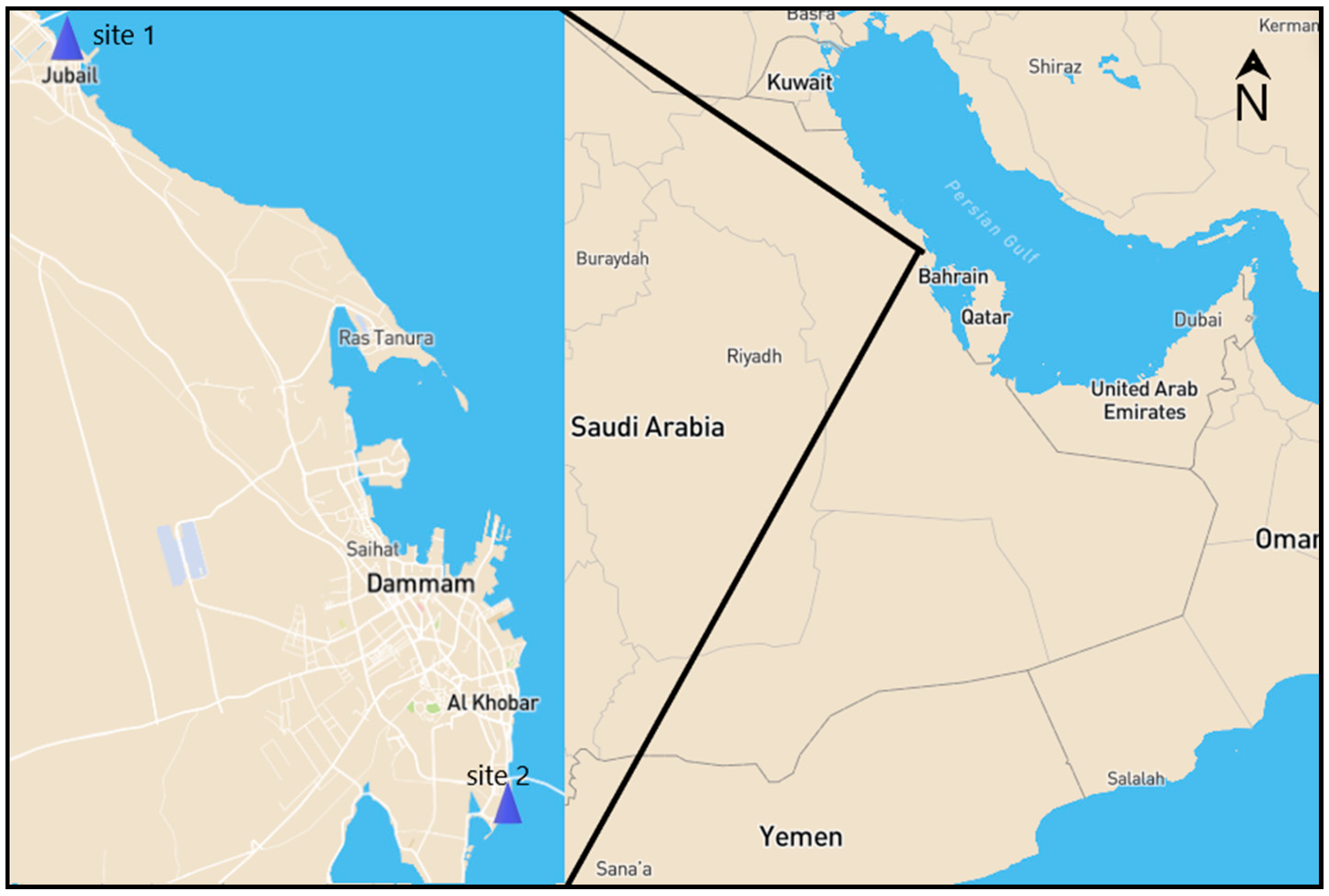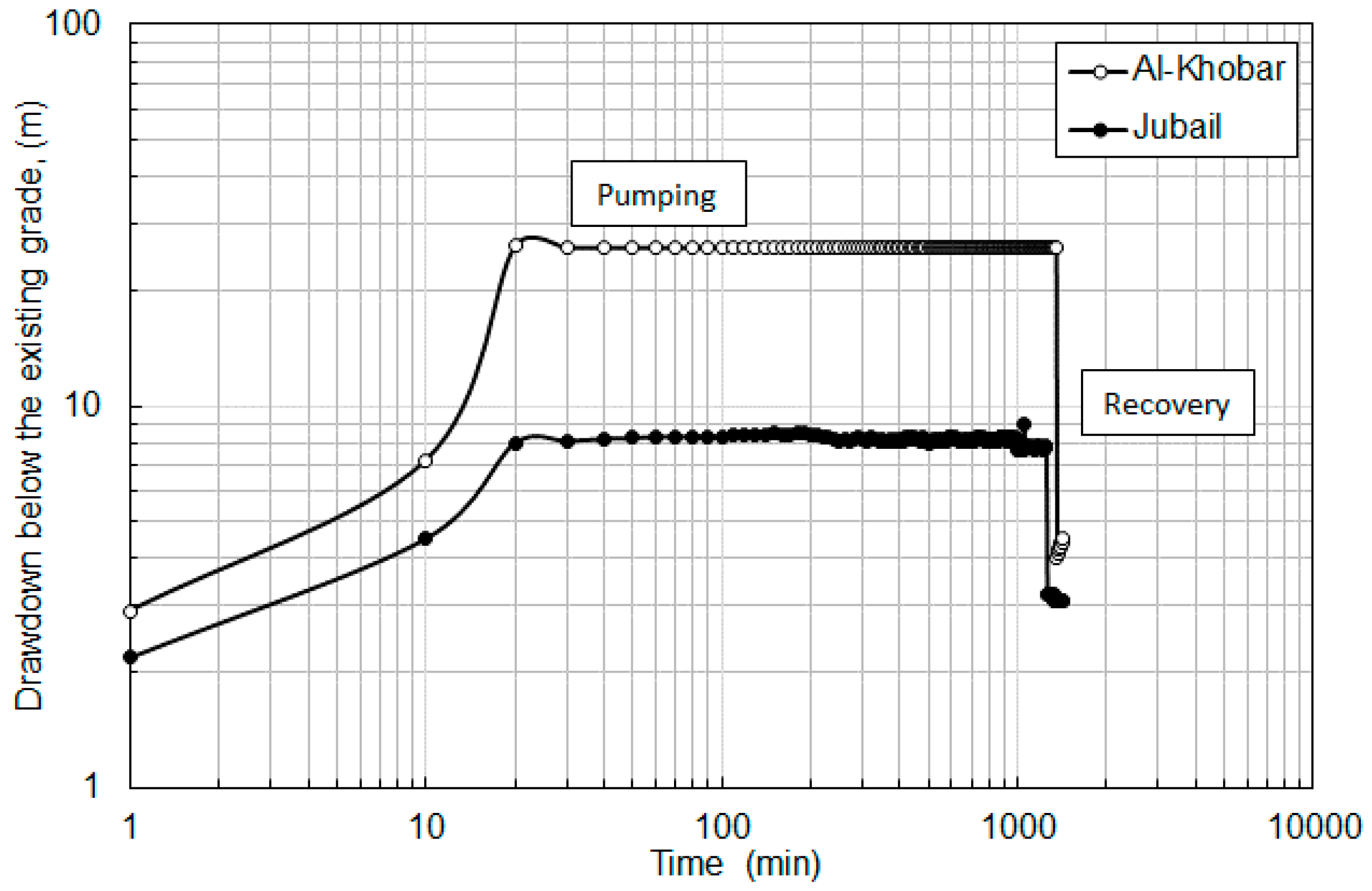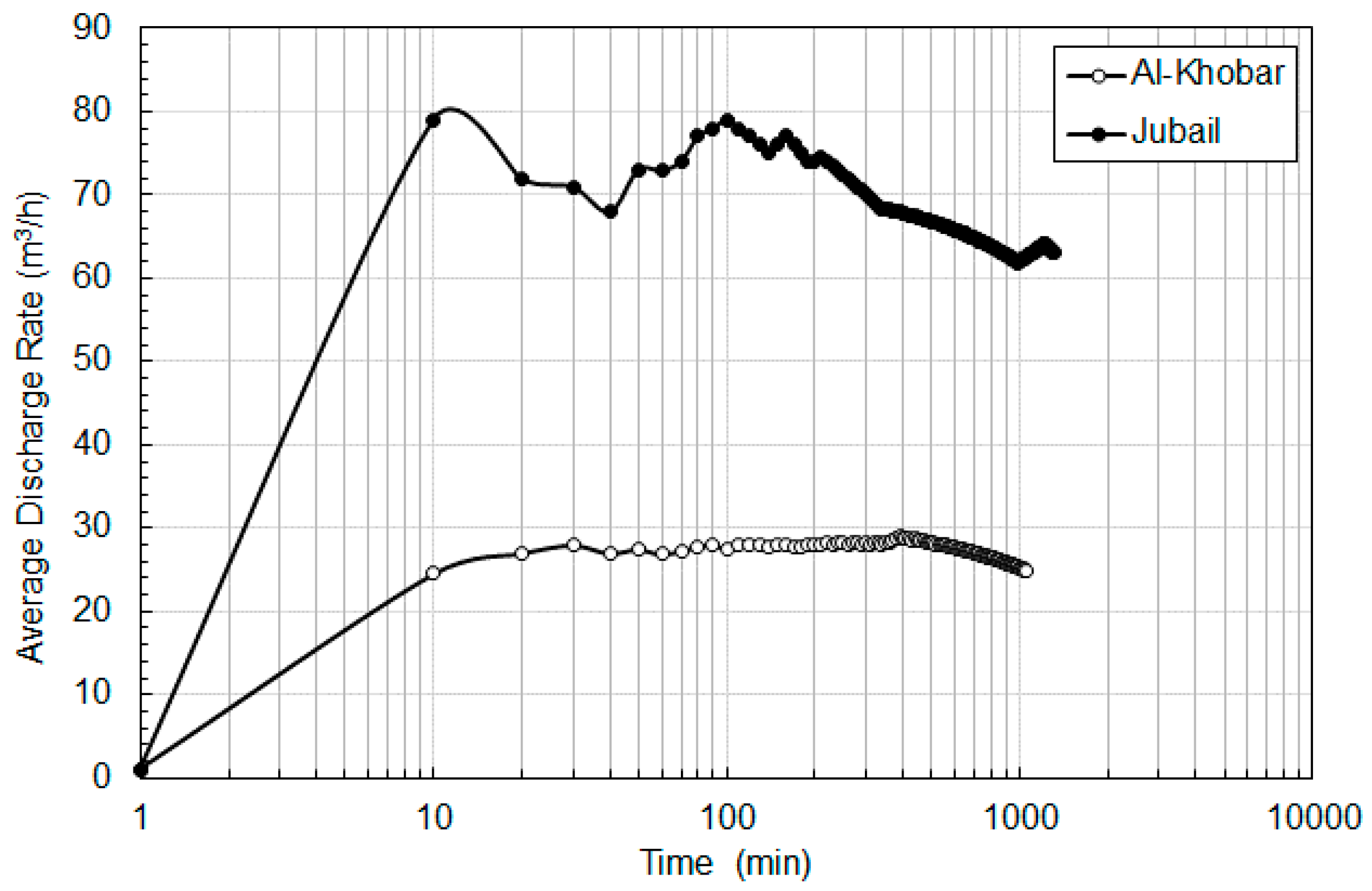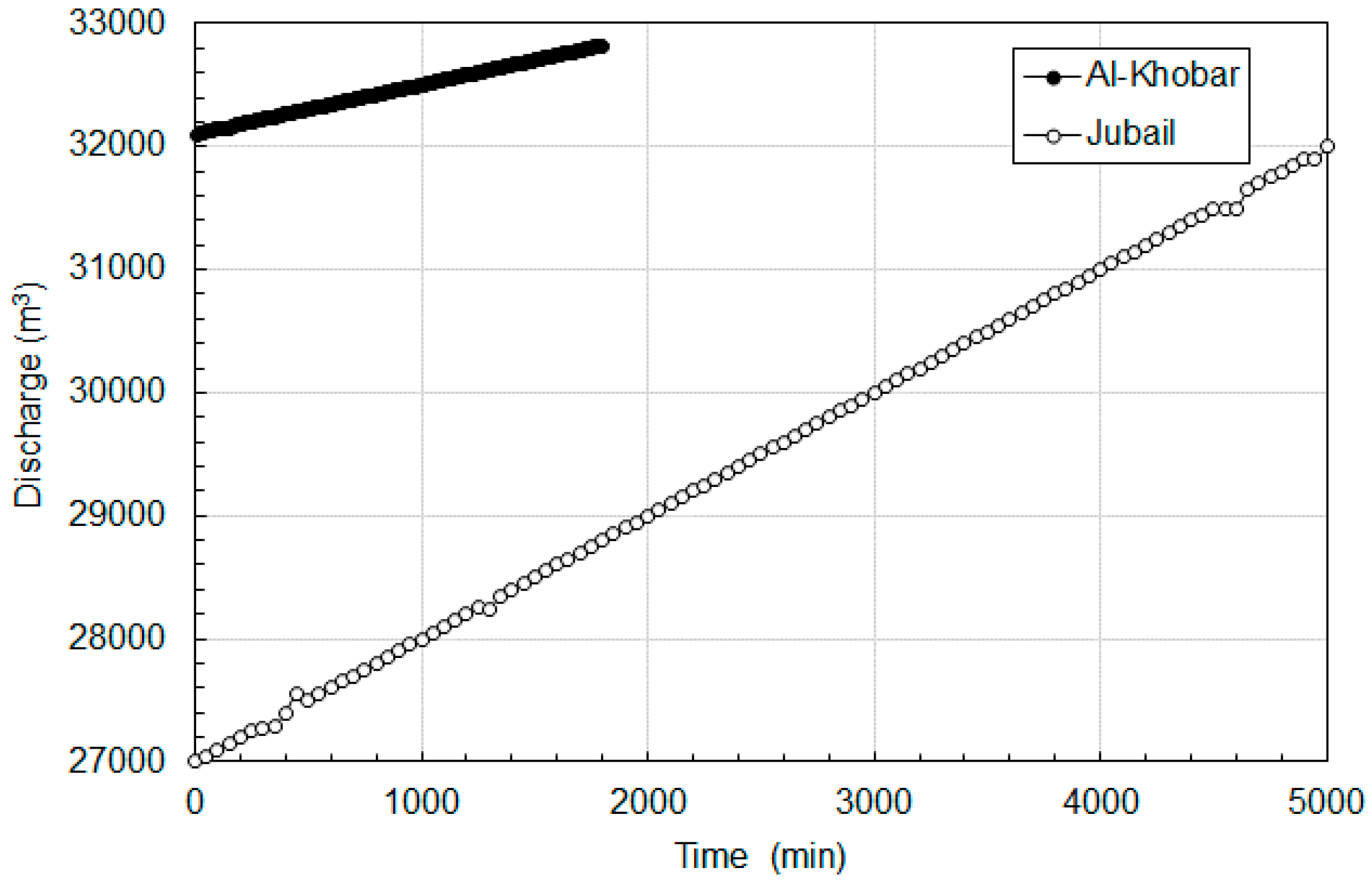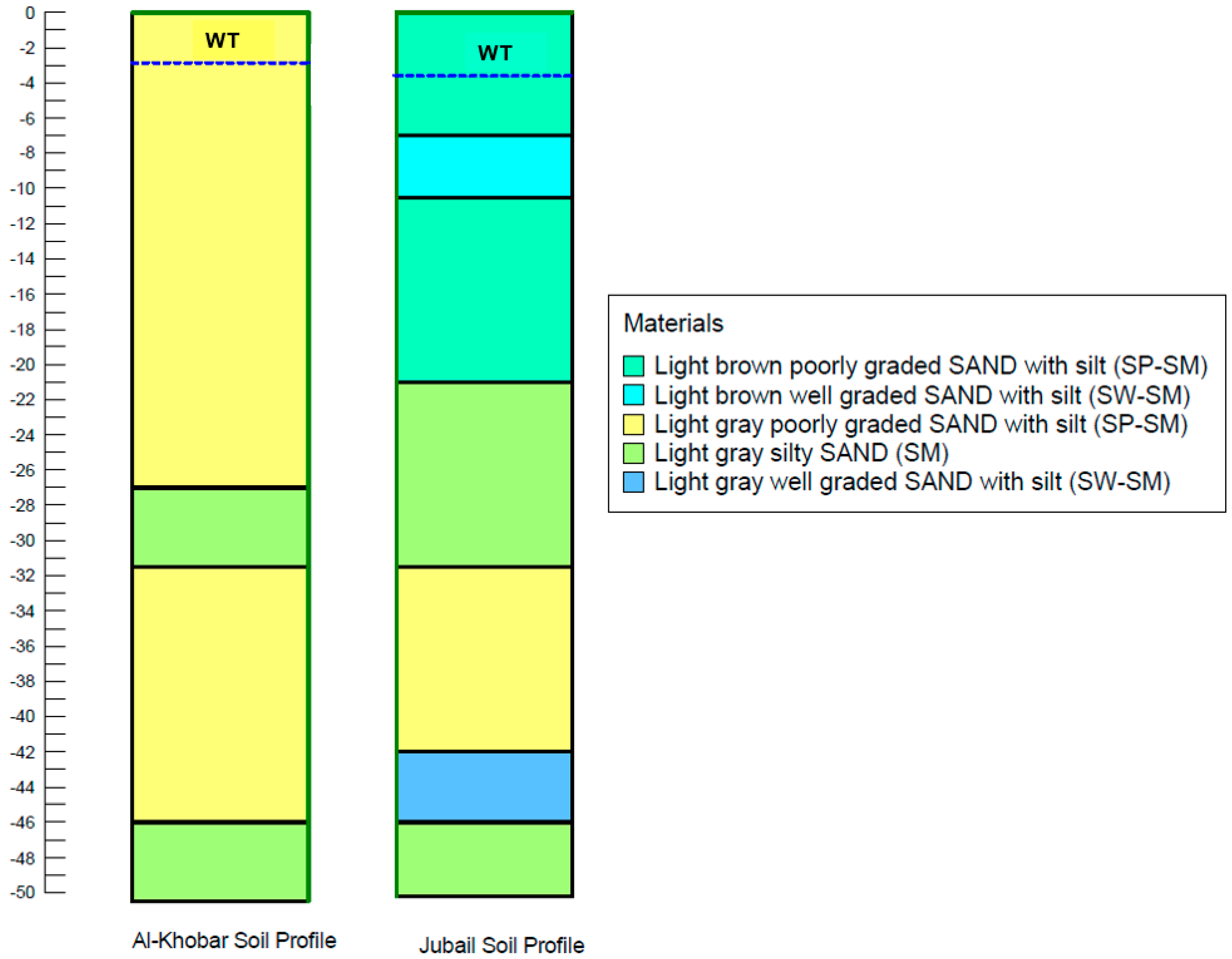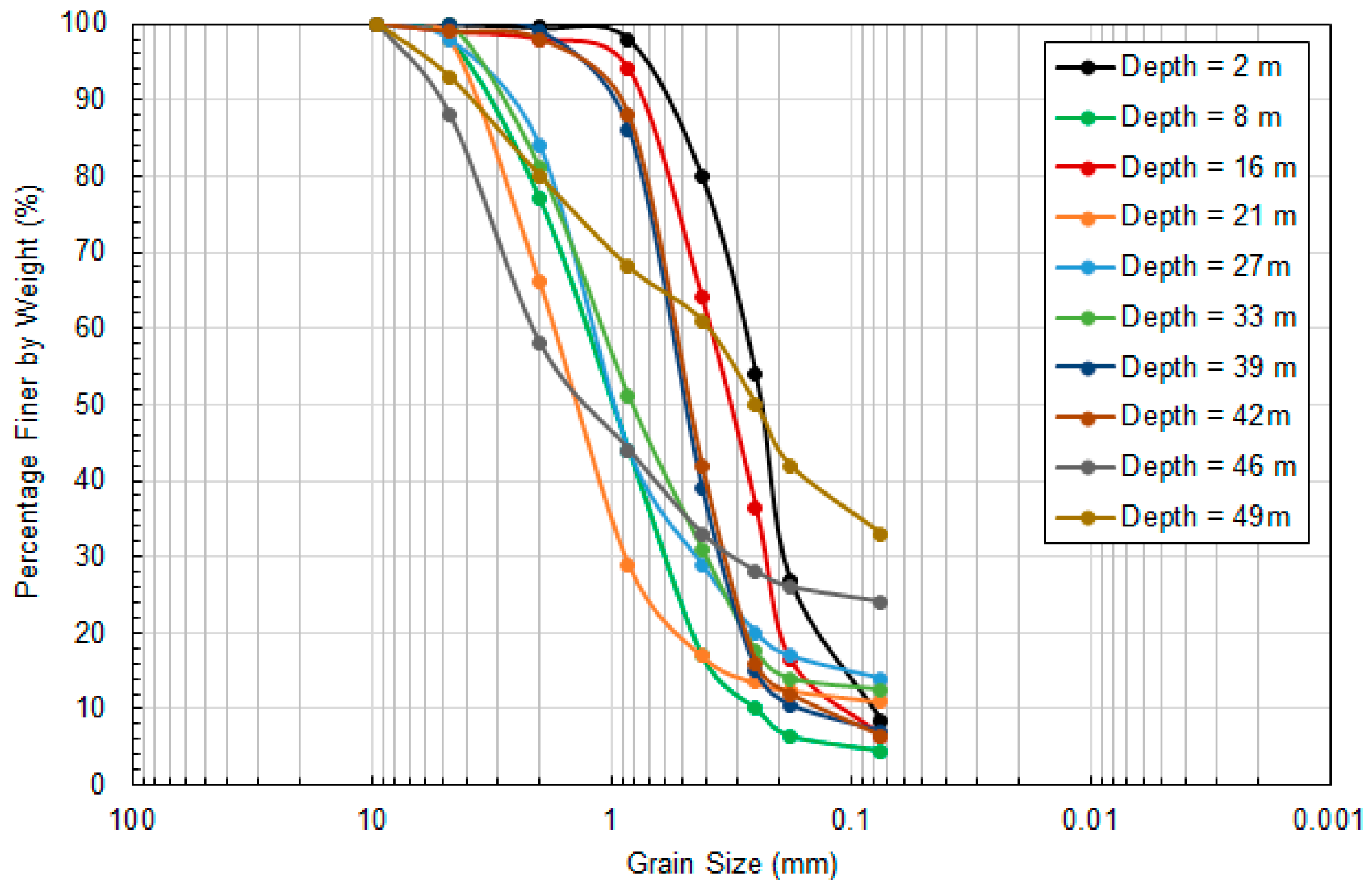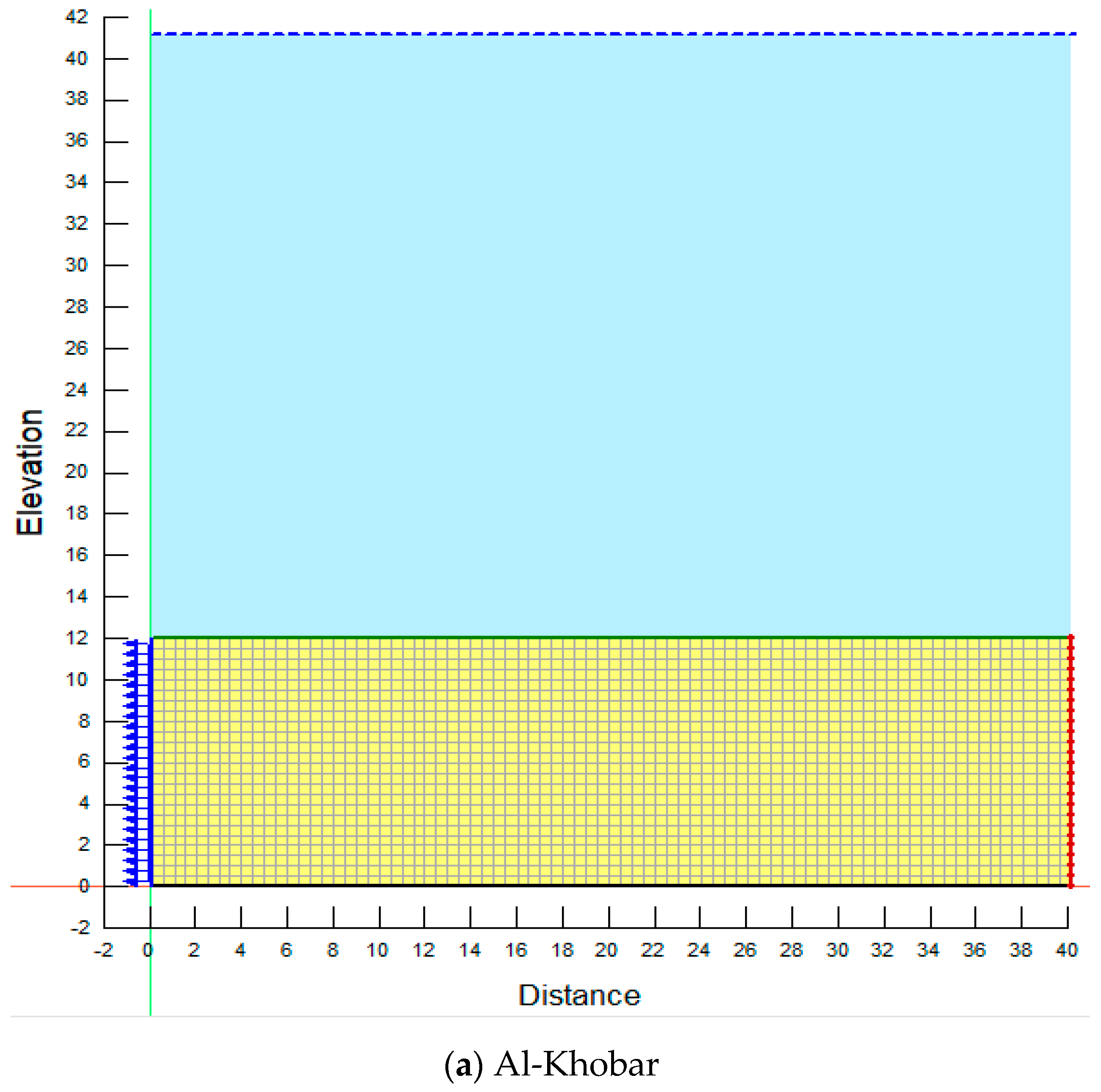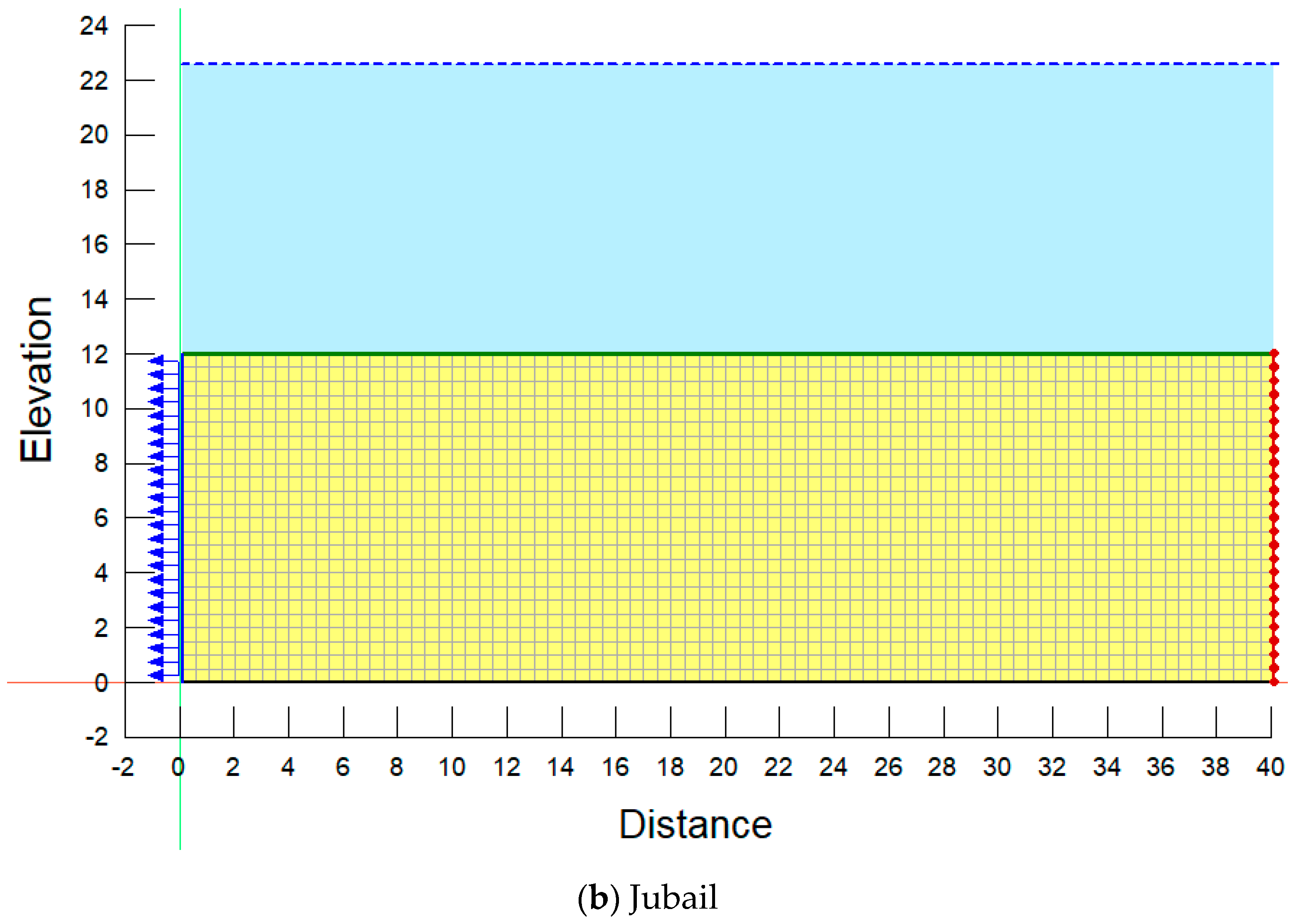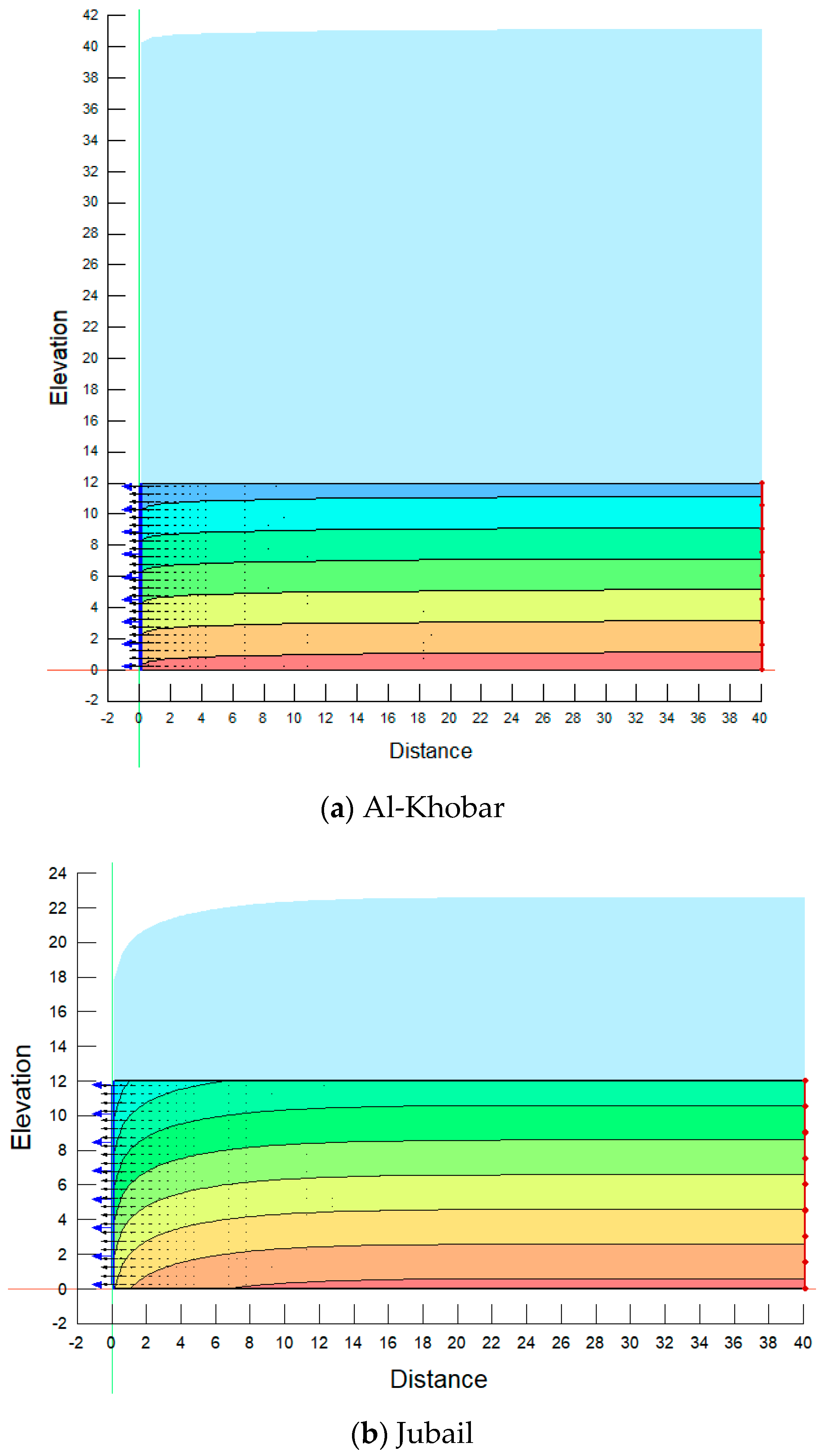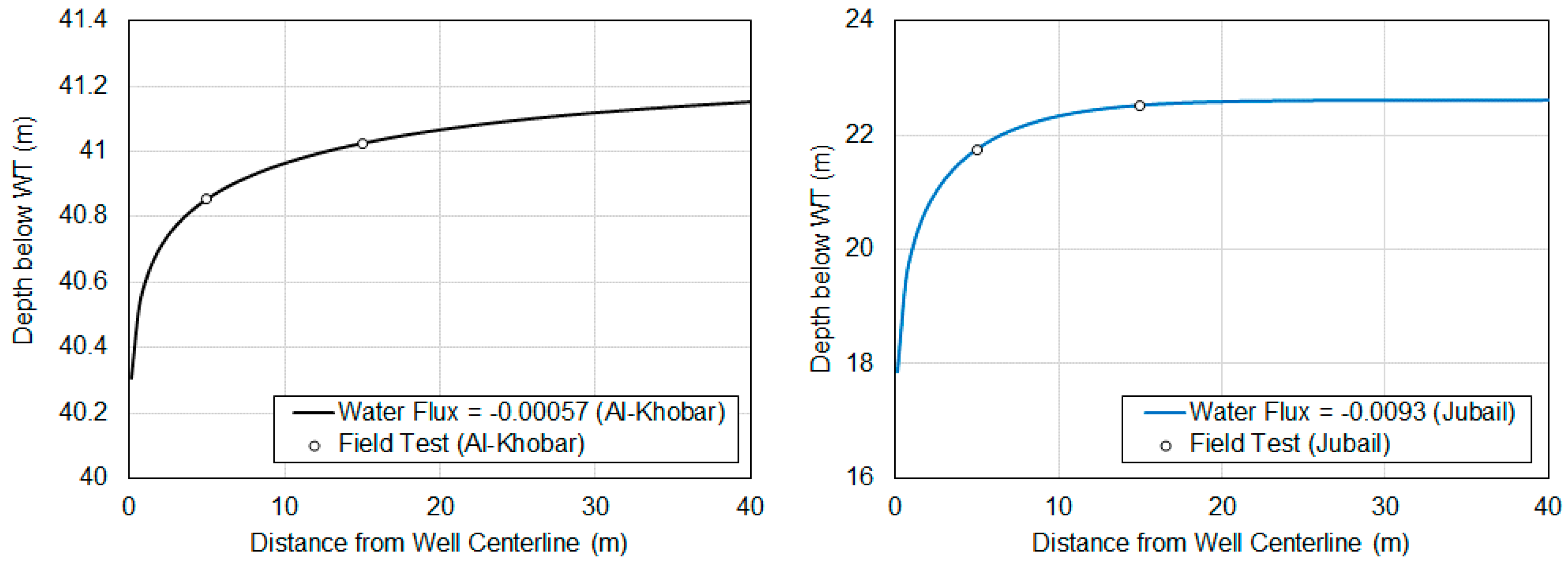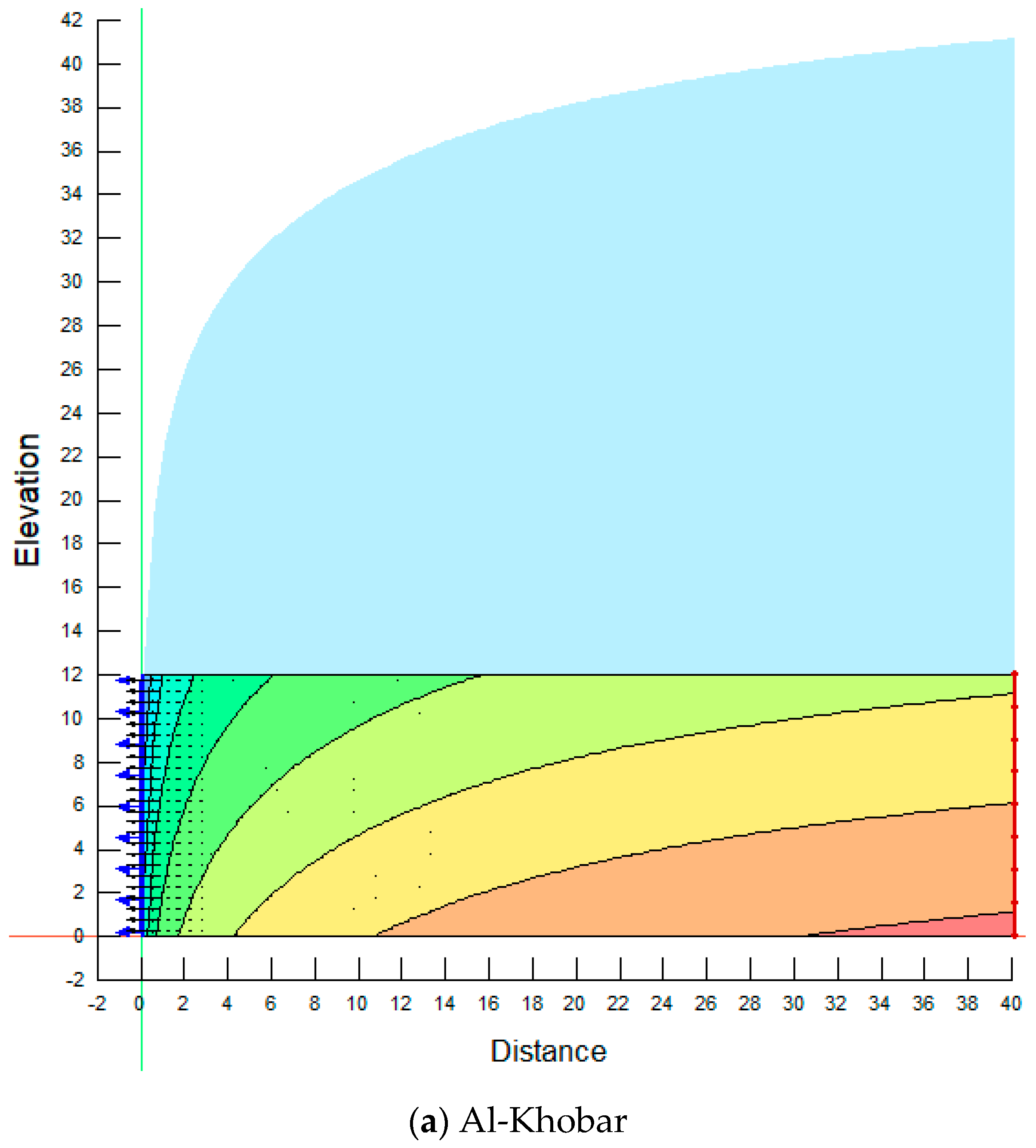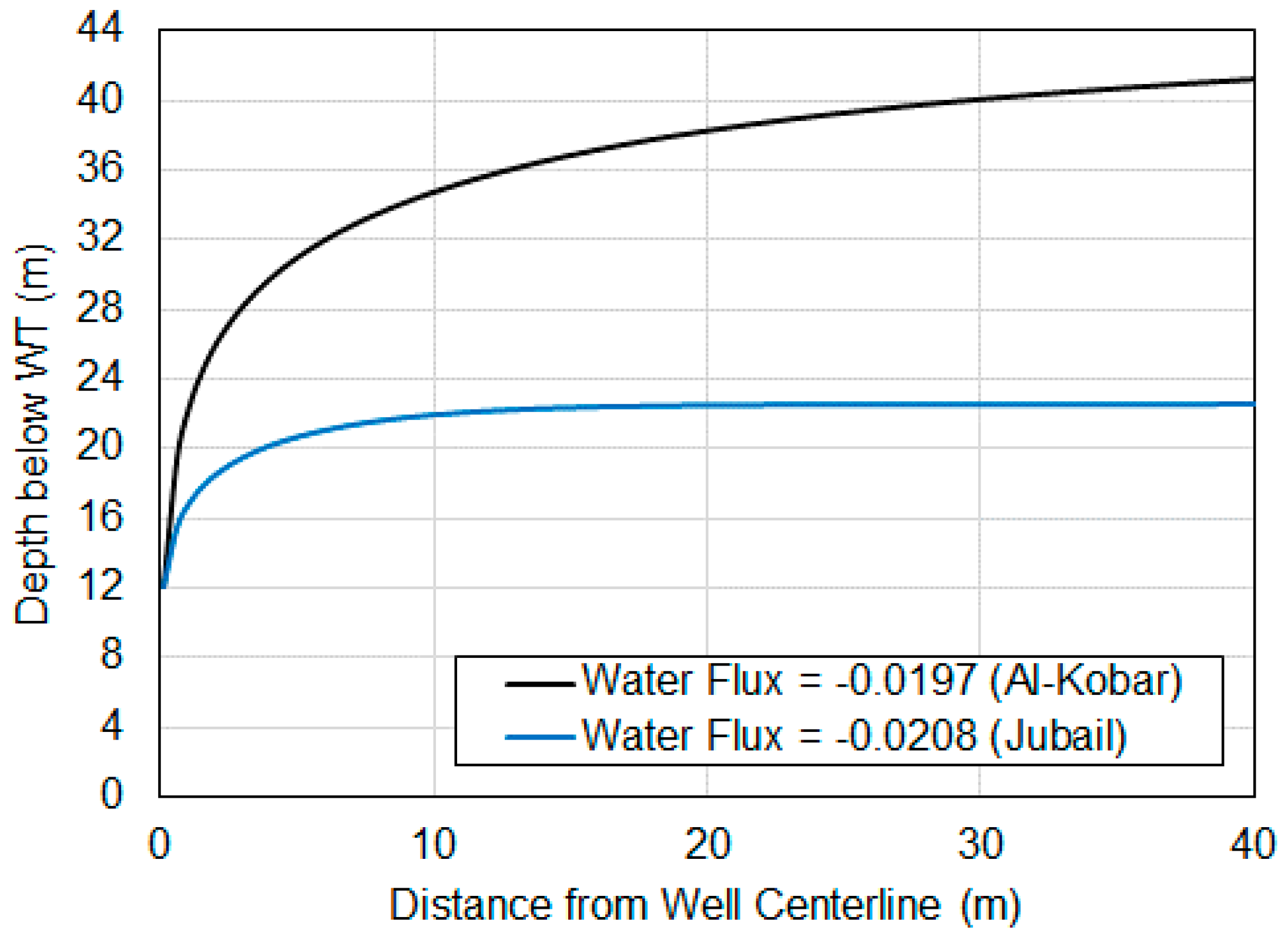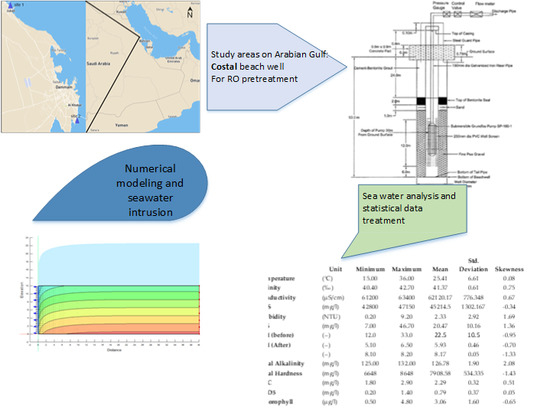1. Introduction
Desalination has contributed to solving the water scarcity problem in semi-arid regions and raised the quality of life during the past five decades. The gulf countries in general and the Kingdom of Saudi Arabia (KSA), in particular, primarily depend on seawater desalination plants built on the coast of the Arabian Gulf to produce potable water. Therefore, desalination will receive significant future investments by the Kingdom for generations to come. However, the technologies used in water desalination are associated with various environmental impacts pertinent to the fragile arid environment, especially groundwater, marine life, air quality problems, and global warming carbon footprints [
1,
2,
3,
4,
5].
At present, KSA is considered the largest user of seawater desalination (mostly reverse osmosis (RO) technology) in the world, with a share of 20% of the total desalinated water production worldwide. Saline Water Conversion Corporation (SWCC) has more than 27 plants that produce 4.6 MCM of desalinated water and 1812 MW of electricity [
6,
7].
A significant concern, however, in the cost-effective application of the reverse osmosis seawater desalination process is the effective control of membrane fouling [
8,
9,
10,
11]. Different types of fouling mechanisms could hinder the production of pure water by RO, including biofouling, organic fouling, scaling, and colloidal fouling [
10,
11,
12,
13]. Biofouling, as one of the types of fouling mechanisms of the RO membrane, is mainly caused by the presence of dissolved or dispersed organic and inorganic matter in the intake water [
7,
9]. The microorganisms’ in the feed stream use organic matter as a food source to grow and multiply on the surface of the membrane and result in a rapid buildup of differential pressure and flux reduction [
1,
7,
11]. Ultimately, this may lead to increased energy consumption and costly maintenance operations that may require the shutdown of the desalination facility [
7,
9,
11].
As a result, many researchers and operators have emphasized the fact that pre-treatment of seawater is necessary to minimize biofouling of seawater reverse osmosis (SWRO) membranes. Despite the crucial efforts to solve the problems of biofouling facing desalination, the main hindrance of the SWRO process is, to date, associated with membrane biofouling. In gulf countries, for example, in Kuwait, conventional coagulation treatment to reduce suspended solids is mainly used to improve feed seawater quality [
7,
12].
A study by Edzwald and Haarhoff on the causes of reduction in the permeate flux during operation found that the phenomenon of biofouling is mainly responsible for limiting the pure water flux during RO seawater desalination to produce purified water followed by cleaning. It was concluded that, during the initial period of cyclic (production and cleaning) RO process operation, the concentration of polarization is one of the main reasons for flux deterioration [
10].
A detailed study by Dehwah and Missimer explained that serious biofouling mostly happens in areas with high nutrient load inputs, such as the Arabian Gulf region. They used a pilot to reduce biofouling at the Jubail SWCC plant in Saudi Arabia and the Ad Dur desalination plant in Bahrain using the same real-feed seawater that is used in the existing polyamide membranes. The best technique to prevent the membrane fouling for water desalination plants was found to be related to the removal of any materials that could be responsible for the formation of fouling agents before they are deposited onto the surface of the RO membrane. Hence, this requires suitable pre-treatment of the feed water before the RO treatment to avoid the occurrence of biofouling [
7,
9].
The existing conventional pre-treatment systems used to reduce biofouling depend mainly on disinfection and chemical cleaning to inactivate microorganisms that cause biofouling. However, the use of these methods leads to extra operation costs, an increased environmental burden, and a shorter RO membrane lifetime. Moreover, most of the processes can be inefficient in extreme cases such as during red tides and algae blooms and cannot meet the requirements of the intake water silt density index (SDI) for reverse osmosis (RO). Recent studies suggest that the disinfection may also have the potential to increase fouling potential [
8,
11,
13].
The biological treatment process has the potential to remove biodegradable organic matter as well as the microorganisms responsible for biofouling. The additional benefit of the biological treatment incorporated with filtering media is the removal of particulate and colloidal matter, which require further treatment schemes in conventional processes [
11,
13,
14].
The use of natural infiltration by drilling beach wells has been explored in the past decades to reduce the SDI and turbidity of feed seawater. Horizontal drilling below the seabed has been tested to enhance the intake seawater quality [
7,
9,
15,
16,
17,
18,
19]. The success of this process is attributed to the natural sand of the seabed pre-filtering the suspended solids from the feed seawater. This system can be operated in a sandy seabed (as in the KSA Gulf areas) and could be an alternative for conventional seawater intake systems. This technology could have economic and environmental benefits over media filtration for seawater intake and pre-treatment [
6,
12,
14,
15].
With the advancement of experimental measuring devices used in aquifer and seawater intrusion assessment and advances in computer performance, hydraulic model experiments and numerical analyses have been extensively conducted [
4,
16,
17].
Several case studies and research studies have been conducted and include numerical analyses of the effects of the seawater–freshwater interface of coastal aquifers and beach wells using different models and experimental setups [
4,
17,
18].
Researchers have investigated the aquifer system and seawater intrusion with various methodologies. Shin, J. and Hwang, S. studied geophysical seawater intrusion through the monitoring of boreholes. Their method included measuring the spatial and temporal variability of groundwater flow through temperature and electrical conductivity monitoring by a thermal in situ sensor. Their study found a rapid reduction in electrical conductivity inside the saltwater zone [
20].
Mohammad M. et al. studied the problem of siltation using a three-dimensional computational fluid dynamics (CFD) model. They studied the sedimentation and the flow in a versatile reservoir. They found that the sediment load levels at numerous points near the intake water were associated with a 3.6% percent bias value, whereas the t-test value was 0.430, which was less than the presented value, demonstrating acceptable model performance [
21].
Vann S. et al. performed a study to outline the problematic intrusion of seawater in a coastal aquifer in Kamala city using geo-electrical examinations. The applied two-dimensional models using the collected resistivity data showed high tenacity subsurface resistivity irregularities of seawater intrusion. The study showed that the concentration of the seawater declines in an eastward direction toward the inland zones [
22].
Sowe M. et al. developed a finite element solute flow and transport model aimed at simulating three different scenarios to evaluate the best suitable water pumping rates, wells number, and optimal well sites from the seashore. The study investigated three different simulation scenarios. The pumping of seawater 1500 m away from the seashore using 16 pumping wells that give a total rate of 8000 m
3 per day was the best operative solution to prevent seawater intrusion in the studied coastal aquifer [
23].
Lee W. et al. studied the equilibrium at the seawater and freshwater interface in a coastal area aquifer using impermeable seawall obstructions. They analyzed the hydraulic features of the coastal aquifer using a numerical analysis model including a Navier Stokes solver that depended on the direct analysis of groundwater flow using the porous body model (PBM). The findings confirmed that the increase of groundwater level in the coastal aquifer due to obstacles leads to an enlarged pressure gradient and eventually to seawater intrusion [
24].
The main aim of this work was to experimentally test the suitability of beach well techniques as a pre-treatment tool for the RO desalination process. Additionally, numerical modeling (SEEP/W) was used to investigate the effects of water flux out of the well at the slotted screen section of the beach well.
4. Conclusions
This work investigated the utilization of the natural process of sand infiltration in beach wells to pre-treat the intake water for the desalination process.
The soil profile testing and classifications indicate that the two studied sites consist mainly of light gray, poorly graded sand with silt interbedded with a 2 m thick layer of light gray silty sand.
Soil classification tests and grain size distribution percentages showed that sand is the predominant soil in the soil profiles of the Al-Khobar and Jubail sites, which ranged between 80% and over 90%. The fines content material that passes through the No. 200 sieve (<0.075 mm) was very small in comparison with sand.
The static groundwater levels indicated that the water level was about 3.60 m and 2.85 m below the existing site grade at the Jubail and Al-Khobar sites, respectively. The 72 h pumping and a 12 h recovery test period for both sites showed a fast increase in the average discharge rate in the first 10 min. The average discharge rate for the Al-Khobar site was 25 m3/h, while for the Jubail site it was 67 m3/h.
The experimental data and numerical modeling were conducted to investigate the effects of well water flux at the slotted screen section of the beach well. The water flux values for the Al-Khobar and Jubail sites were 0.0197 and 0.0208 m3/s/m2, respectively, which correspond to 72 m3/h/m2 and 1356.48 m3/h/m2. In terms of the rate of pumping flow, the model suggests production can be increased by 20 and 53 times the measured production of the Jubail and Al-Khobar sites, respectively.
The beach well water quality experimental results show that SDI15 values ranged between 5.1 and 6.2, which indicates beach well sand filtration in the Eastern Province would be a valuable pre-filtration step in reverse osmosis (RO) to be used without conventional chemical pre-treatment for the RO water purification process. The outcome of our findings is to suggest to the stakeholders at the Saline Water Conversion Corporation (SWCC) in Saudi Arabia that they undertake a scientific study on the selection and utilization of beach well intake options in the eastern part of the Kingdom of Saudi Arabia (KSA) for seawater pre-treatment. This option will be especially useful during extreme Gulf water pollution, such as during oil spills and algal blooms.
